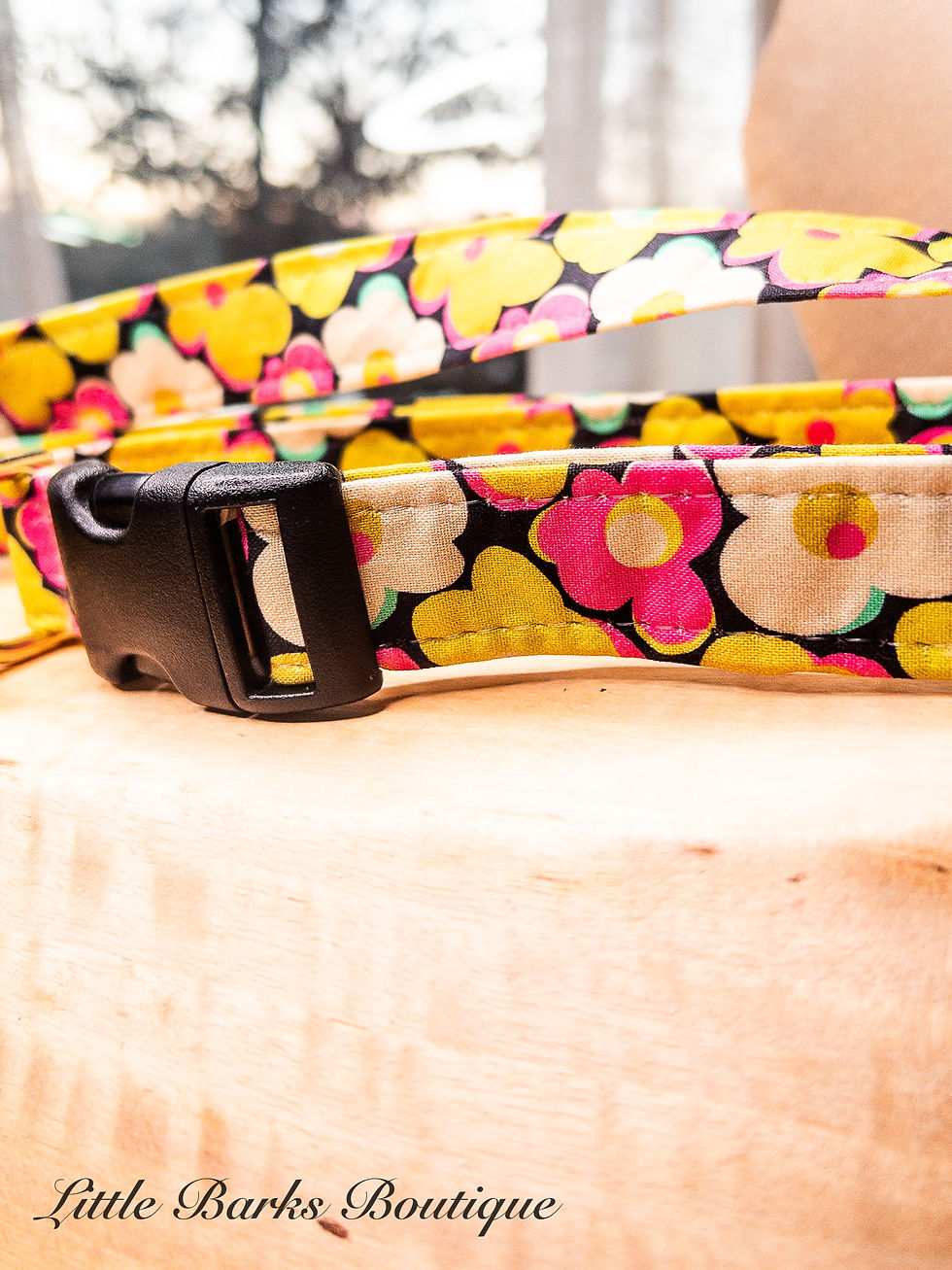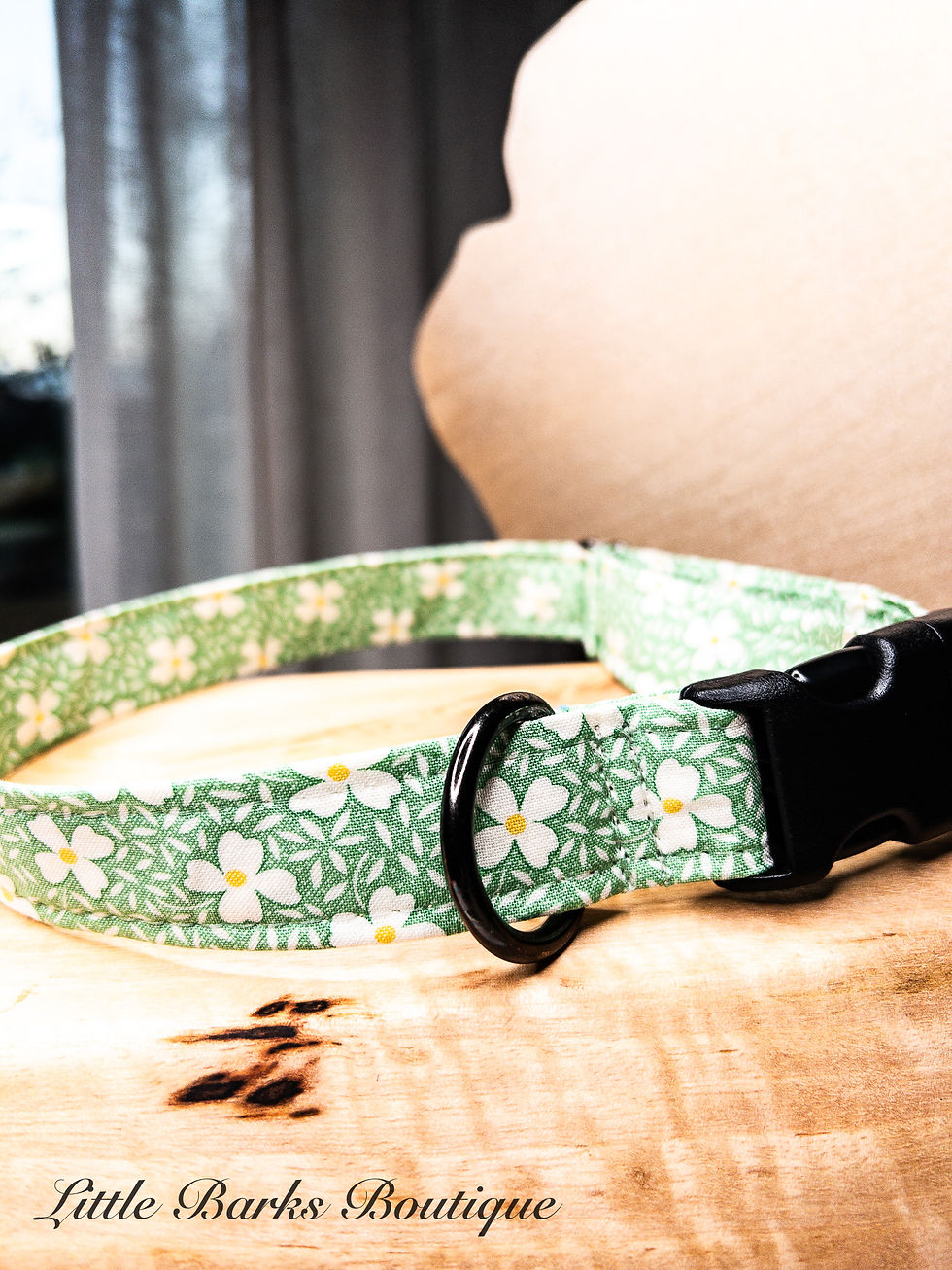Choosing the Perfect Dog Collar: A Comprehensive Guide for Pet Owners
- Kim Kier
- Sep 5, 2023
- 5 min read
Updated: Apr 19, 2024
Are you a proud pet owner on the hunt for the perfect dog collar? Look no further!
In this comprehensive guide, we'll walk you through everything you need to consider when choosing the ideal collar
for your furry companion.
Finding the right collar for your pet goes beyond just picking a color or design.
It's about selecting a collar that is comfortable, safe, and suits your dog's unique needs and personality. Whether you have a small, large, or active dog, we've got you covered. In this Blog post, we'll delve into the different types of dog collars available, including everyday collars, training collars, and specialty collars like Little Barks Boutique Collars.

We'll also explore the various materials and features to look for, such as adjustable sizing, and durable hardware. As pet owners ourselves, we understand the importance of finding a collar that not only looks great but also serves its purpose effectively. So, if you're ready to find the perfect dog collar that will keep your furry friend safe, secure, and stylish, let's dive in!
The importance of choosing the right dog collar Your dog's collar is not just a fashion statement; it serves a vital purpose. It is not only a means to attach a leash but also an identification tag holder. Ensuring your dog wears a collar at all times with proper identification is essential in case they get lost. Additionally, a collar helps in controlling your dog during walks and provides a sense of security. Dog collars come in various types, each serving a specific purpose. Everyday collars, also known as flat collars, are the most common type. They are designed for daily wear and typically have a buckle or snap closure.
Speciality collars, on the other hand, are collars with a specific purpose .
These include soft choke collars, martingale collars. Considerations when choosing a dog collar - size, material, and durability.

When selecting a dog collar, it is crucial to consider your dog's size and breed, after 23 years of serving dogs in the grooming industry and beyond one thing I notice is most mass produced dog collars do not FIT properly for many dogs. A proper fitting collar is not only comfortable for your pet , IT IS A SAFETY ISSSUE. Every dog is unique and sizing and fit matter !
A collar should fit snugly but not too tight to restrict breathing or cause discomfort. Measure your dog's neck circumference using a soft tape measure for an accurate size. Additionally, the material of the collar plays a significant role.
Cotton dog collars are lightweight and easy to clean. Safety features to look for in your dog's collar
STITCHING MATTERS - a tight stitch width with a strong thread is essential for durability and safety , Little Barks Boutique Dog Collars are made with UV resistant 50w Monofilament thread graded for use in Sailboat sails , strength and function is key.
HARDWARE - Buckles, D-rings and collar slides all make up the functional part of a dog collar, QUALITY MATTERS. Little Barks Boutique Dog Collars are Crafted with USA sourced hardware , from companies that specialize in pet hardware, from the top rated names like wienerlock
INNER CORE - Cotton Dog Collars all have a inner core to add strength and function to the Collar, some use nylon webbing or simple interfacing , both work, nylon is heavy and yes durable but can be uncomfortable for your pet. Interfacing core collars are classified as "Decorative only" collars. Little Barks uses a lightweight Dyneema® Webbing has superior strength without all the bulk! With 15 times the strength of steel, Dyneema is one of the strongest fibers in the world.
OUTER BEAUTY- High quality cotton fabrics is the FIRST IMPRESSION OF ANY COTTON DOG COLLAR, but it is more than just good looks and here are some reasons why. Durability , we want the collar to last and be safe. Fading and Bleeding of the fabric can almost always happen with low quality fabrics. Comfort is a priority is one of the reasons we choose a Cotton dog collar, cotton is for the soft and cozy feel, but low quality cotton fabrics can be stiff with their low thread count.
Your dog's safety should be a top priority when choosing a collar.
If you do not connect a leash to your dogs collar you may want to Opt for collars with quick-release buckles to ensure easy removal in case of emergencies. Breakaway collars are designed to release when pressure is applied, preventing the risk of strangulation.
Additionally, inspect the hardware of the collar. Ensure it is strong and securely attached to prevent accidents or your dog from escaping. How to measure your dog for a collar Proper measurement is crucial to ensure the perfect fit for your dog's collar. Use a soft tape measure to measure the circumference of your dog's neck, just below their ears. Add two fingers' width to the measurement to allow for comfort. It's essential to measure your dog periodically, especially during growth phases, to ensure the collar remains fitting correctly.

Personalization options for dog collars Many pet owners like to personalize their dog's collar to add a touch of uniqueness. Embroidered collars allow for customization with your dog's name or contact information. Personalized collars not only look stylish but also provide a practical way to identify your dog. Training collars vs. everyday collars Training collars and everyday collars serve different purposes, so it's essential to choose the right one for your dog. Everyday collars are suitable for general use and provide a secure attachment point for a leash. They are comfortable for your dog to wear all day.
Speciality collars, however, are designed to help with a specific behavior or problem. Such as a Martingale collar , keeps your dog from escaping from his collar. This might be a great choice for a vet visit when your dog is more anxious or if your dog backs out of a traditional buckle collar.
Tips for maintaining and cleaning your dog collar To prolong the lifespan of your dog's collar, regular maintenance and cleaning are necessary. Cotton collars can be hand-washed using mild soap and water. Ensure the collar is completely dry before putting it back on your dog. Regularly check the collar for any signs of wear and tear, such as frayed edges or loose stitching, and replace it if needed.
Finding the perfect dog collar for your furry friend Choosing the perfect dog collar is a decision that requires careful consideration. By understanding the different types of collars, considering your dog's size and needs, and prioritizing safety features, you can find the ideal collar for your furry friend. Remember to measure your dog accurately, and personalize the collar to add a personal touch. With the right collar, your dog will not only look stylish but also stay safe and secure during all your adventures together. Happy collar shopping!




Comments